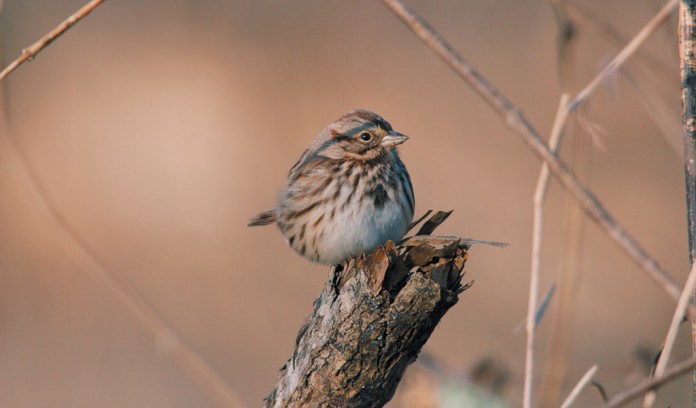I’m often asked why I love birds. The answer is simple: they please my eyes, ears and brain. Even common backyard birds are eye candy.
Give me chickadees, or give me death. When brightly colored species such as cardinals, bluebirds, and scarlet tanagers appear, they dazzle me.
I can’t stop watching until they fly away. I love their voices. From the simple trills of chipping sparrows to more complex songs of wood thrushes and indigo buntings, they truly are music to my ears.
Early mornings
On spring mornings I listen from bed to see how many species I can identify by sound. And their behaviors never cease to fascinate me. Small songbirds frustrate larger predatory owls and hawks by mobbing them.
Turkeys and ruffed grouse bathe along dusty gravel roads. And year after year tiny hummingbirds travel more than 1,000 miles to return to feeders on my back porch. Yes, I love birds.
Interest grows
And I find my affection for them grows as I get older. There are always at least two feeders in view as I work, and every time I look up, I smile.
I can’t imagine a world without birds. A friend recently reminded me that one need not be an ornithologist or even a serious birder to share my enthusiasm for birds.
During my Oklahoma years (the early 1980s), Dan Sebert became a good friend. We recently reconnected via Facebook.
Dan lives in north-central Oklahoma and is a hunter and a professional conservationist. He worked for the Oklahoma Conservation Commission for many years, and now works for the National Watershed Coalition.
In his spare time, he raises mules. We were kindred spirits, but I never considered him a birder.
Facebook post
Dan’s most recent Facebook post has had me smiling for days. He gave me permission to share it.
This morning I was checking hog traps down in the bottom and caught a glimpse of blue flitting through the trees … my brain woke up and said, “not a bluebird.”
So I rolled on down the fence line and saw it again as it flew into a cottonwood and lit on a branch about 45 feet above the ground. At that point, I’m digging around in the truck for the binocs I left at home.
So I grabbed a scoped rifle from the back seat. The bird still sits patiently while I find it in the scope.
It’s a male Painted Bunting! I had never seen one before, but have looked for one off and on for 30-plus years!
Here’s where it gets even birdier. A female flies in and lands next to the male. I dial the scope back to 6-x and get a really good long look, pumped out of my gourd.
Then they fly off. As I marvel at what I saw, I whip out my trusty iPhone with the Audubon app. I go to the “painted bunting” screen and marvel at this beautiful bird.
The thought crosses my mind that God looked in a drawer and saw some leftover bird parts from several different models and decided to throw them together, and the result was a Painted Bunting.
Bird song
Then I play the bird’s song from the app and listen. I can hear the real bird singing out in the wooded bottom. Then I play it again.
The male returns and lands 20 yards in front of the truck. I hit play again, and he flies up to the truck and lands about five feet outside the window … unbelievable!
Went to see if I had caught nature’s ugliest and most ecologically foul beast and ran into beauty along the way. Too cool for school. Whew, what a morning!
Anyone who has ever seen a Painted Bunting can understand Dan’s reaction. It is arguably the most beautiful bird in North America.
In fact, one of its common names is “nonpareil,” a word meaning “without equal.”
The male is a small songbird with a bright blue head, red breast and belly, red eye ring, and green back. It is truly a bird without equal.
Dan, thanks for the memories. And welcome to the club.













